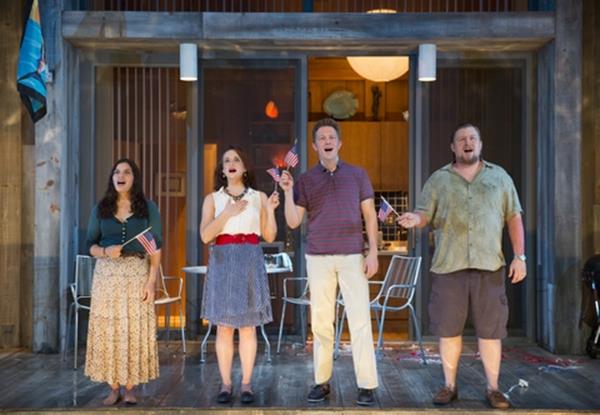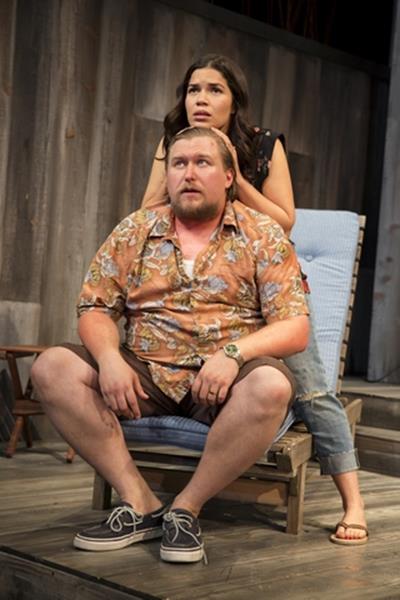Lips Together, Teeth Apart
First major revival of McNally's 1991 play set on Fire Island in which two heterosexual couples respond to the AIDS crisis seems to have dated badly.

America Ferrera, Tracee Chimo, Austin Lysy, and Michael Chernus in a scene from “Lips Together, Teeth Apart” (Photo credit: Joan Marcus)
[avatar user=”Victor Gluck” size=”96″ align=left ] Victor Gluck, Editor-in-Chief[/avatar] When Terrence McNally premiered Lips Together, Teeth Apart in 1991, the world was in the throes of fear over the AIDS epidemic. This long three-act play about how two straight couples deal with their reaction to it must have seemed topical and profound at the time. Unfortunately, 23 years later, in Peter DuBois’ revival for Second Stage Theatre, the play now seems dated and talky without the emotional heft to make it still seem important. Following in the footsteps of original cast members Nathan Lane, Christine Baranski, Swoozie Kurtz and Anthony Heald, the new cast made up of Michael Chernus (Manhattan, Orange is the New Black), Tracee Chimo (Bad Jews), America Ferrera (Ugly Betty) and Austin Lysy (Law & Order: Special Victims Unit) are unable to make us care about these troubled characters and their petty jealousies.
It is July 4th weekend, 1990, on Fire Island. Sally Truman has inherited a magnificent beach house in an up-scale but very gay neighborhood from her brother David who has recently died of AIDS. With her is husband Sam, a contractor from New Jersey, his sister Chloe Haddock (the mother of three children not with her this weekend) and her husband John, an administrator at a posh private school in Connecticut. Sally is both angry and guilty: she loved her brother but could not deal with his homosexuality. In fact, when she met his black lover Aaron, it appears she had little to do with them after that until he ended up in the hospital dying. He had been her best friend but she feels bereft that he was taken away too soon.
However, all of the characters are suffering in some way. Her husband Sam (with whom she has not been able to have children up until now) is both prejudiced and uncomfortable around gay men: “Imagine if they thought we were queer. I’m gonna sit with my legs apart and smoke a cigar all weekend.” Aside from Chloe, the other three spend the day turning down the kind invitations of their gay neighbors to join them for 4th of July festivities. Sam also worries that Sally has been unfaithful and that he might be losing her.
His brother-in-law John has been diagnosed with terminal cancer but doesn’t want anyone to know or pity him. His wife Chloe is more hyper than usual as she attempts to deal with the imminent loss of her husband. She talks non-stop, peppers her conversation with French, and rushes around offering to make food for the others. This couple with children are glad that they are having a weekend away, while the other couple are ambivalent about having children. None of them know how to keep children safe.
It is not clear until halfway through the third act where the play is going: Sally finally says what everyone is thinking but no one dares say: “None of us are ever going to go into that pool so can we just stop talking about it? … We all think it’s infected. We all think it’s polluted. We all think we’ll get AIDS and die if we go in.” The play is really about the reluctance of heterosexuals to confront AIDS back in 1991. Allusions to death and dying abound throughout the play while the two couples attempt to have a good time and make small talk: a drowning man that Sally thinks she sees in the ocean is a reminder of her brother, a dead snake that Sam brings up from under the house scares Chloe, the bug zapper is continually killing mosquitoes. These are all people who are pretty blatant about their prejudices but would be the first to say that they don’t know any gay people – except at work.
Of course, two decades have passed and we feel superior to these characters who have groundless fears and much misinformation. However, the two and a half acts that lead up to this revelation aren’t very deep. Sam and Chloe talk about brother/sister memories. John watches Sally paint the ocean. It becomes obvious that Sam has a poor self-image and Chloe has a pretty good idea about how superficial she is. There is a rivalry between the two men, the elitist John and the blue-collar Sam, that suddenly erupts into violence and then they both feel contrite. We see them throughout the day and when it is all over we don’t really like them any more than we did at the beginning.

Michael Chernus and America Ferrera in a scene from “Lips Together, Teeth Apart” (Photo credit: Joan Marcus)
Aside from monologues in which each characters’ unspoken thoughts are broadcast to the audience, director DuBois has not helped his actors find their subtext in this Chekhovian drama in which much is said but little happens. Chimo’s Chloe who never stops talking is obnoxious (even her husband tells her to “Shut up”) without having any redeeming qualities – even when we discover the reason she is like this. As played by Lysy, her husband John seems numb from his unequivocal diagnosis and ultimately very distant. Ferrera’s Sally is obviously on a search for answers but she comes across as unsophisticated and childlike, rather than a quester in search of truth. Chernus’ Sam is perplexed and disturbed but sounds superficial with the lines that McNally has given him, rather than a man who finds himself out of his depth. By the end, the play seems to have taken a long time to get to its objective. In 2014, itt now seems more of a period piece than a window on an earlier time.
The single most effective element is Alexander Dodge’s attractive wooden patio setting with its two bedrooms on either side of a well-equipped kitchen, and a real pool at the apron. Not only does it seem as expensive as described but one can imagine it as an idyllic spot to vacation. ESosa gets a certain amount of humor out of the costumes as the couples change clothes, worry about whether things match or what their outfits say about them – all the while thinking that their neighbors are judging them. Justin Townsend’s lighting beautifully delineates the three time periods and is particularly effective with the third act fireworks at the play’s climax. Fitz Patton’s sound design is responsible for the various snatches of music that come from the Trumans’ neighbors at different times of the day and punctuate the action.
McNally’s Lips Together, Teeth Apart is a real disappointment as a legendary play not seen by many in its original limited engagement first production at Manhattan Theatre Club. The new cast does not give the kind of in-depth performances that might make this more than a view of an earlier age. The odd title refers to a technique for trying to break a habit of grinding one’s teeth in one’s sleep. Like the play, it does not seem like an extremely meaningful piece of information though by the end we know why these people are not sleeping soundly.
Lips Together, Teeth Apart (through November 23, 2014)
The Second Stage, 305 W. 43rd Street, in Manhattan
For tickets, call 212-246-4422 or visit http://www.2st.com
Running time: two hours and 35 minutes including two intermissions






Leave a comment